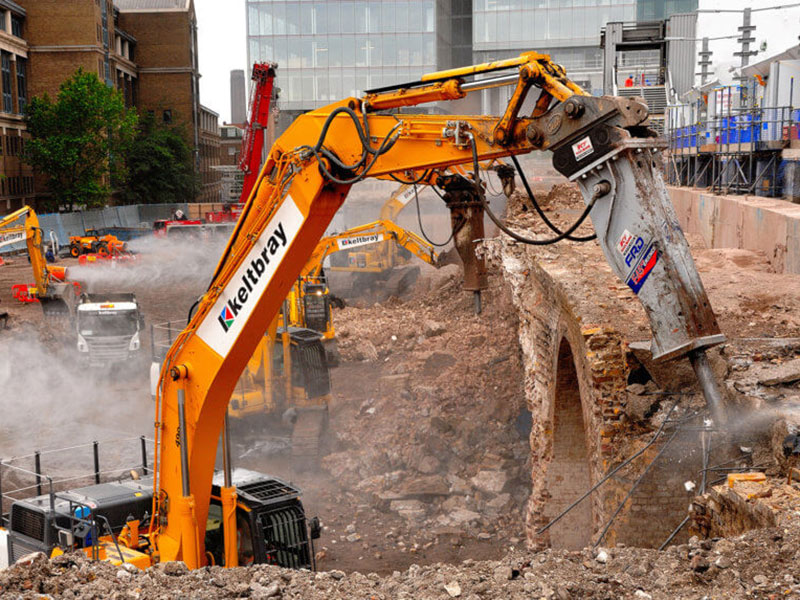What are the issues and risks when removing asbestos from buildings being demolished?
Between the 1950s and the 1980s, asbestos was commonly used in construction in the UK. It was great for fireproofing, soundproofing, and adding durability to materials like concrete.
However, it was found that it was extremely dangerous to inhale asbestos fibres. That was something that wasn’t known when its use was so prominent.
Since learning about its dangers, some ACMs were removed from buildings. Many still exist, though. This poses a problem when demolition is about to take place.
It’s safe to assume that asbestos is present in any building constructed before the year 2000. And since demolition can damage asbestos-containing materials (ACMs), there’s a potential for exposure. That’s why a team of professionals must remove the ACMs before demolition starts.
Issues and risks of asbestos removal during demolition
Demolition work can knock down, crush, and cut ACMs. This can release harmful asbestos fibres. Here’s how that can become a huge problem.
Disturbance and release of asbestos fibres
In an undamaged state, ACMs don’t pose a risk. When disturbed, though, microscopic fibres can release into the air and spread. When inhaled, these fibres stick to the lungs. Over time, this can cause serious and life-threatening health issues.
Identifying ACMs before work begins helps keep workers safe during a demolition job. When ACMs go undetected, damage can occur without anybody realising it. Asbestos fibres aren’t always visible to the naked eye. That makes it possible to unknowingly breathe them in.
Health risks to workers and the community
Once fibres lodge themselves in the lungs, they’re impossible to remove. Fatal diseases and cancers can take years to develop. These include asbestosis, diffuse pleural thickening, lung cancer, and mesothelioma.
For workers, the best defence is wearing protective equipment when working with ACMs. This includes disposable gloves and overalls, boots without laces, and respiratory protective equipment.
Environmental concerns
Poor planning can cause demolition projects to release asbestos into the environment. This can result in different types of contamination:
- Air contamination; inhaling asbestos fibres is possible
- Soil contamination; when disturbed, soil can release fibres into the air
- Water contamination; ingesting asbestos is possible
It is also worth considering that asbestos doesn’t break down with time, and it’s not biodegradable. Environmental contamination can cause problems indefinitely.
Mitigating the asbestos issues and risks for a demolition project
To ensure that a demolition project doesn’t disturb asbestos, a survey must take place first. There also needs to be an asbestos management plan in place. Then, experienced asbestos professionals will handle removal before the demolition team begins work.
Pre-demolition asbestos surveys and assessments
Before demolition, you must have a complete assessment of the ACMs present on-site. Have a surveyor access all areas of the premises to conduct a demolition survey. They’ll need the following to carry out the survey:
- Building plans and specifications
- Layout of the site
- Keys, access codes, etc.
- History of asbestos work
- Knowledge of hazards
- Safe access to heights
The surveyor should be able to access as much of the site as possible. This includes hard-to-reach sections, such as roof voids and wall interiors.
The survey must have the location and identification of all ACMs and debris. It’s not necessary to record the condition of the ACMs. Surveyors should note ACMs that are in a dangerous state, though.
Also, the report should include the areas where the surveyor did not visit. To be safe, assume that there is asbestos in the areas the surveyor didn’t access.
Once the survey is available, an asbestos management plan should be drawn up. This will include mechanical and manual processes for removing ACMs pre-demolition. It is also wise to include a risk assessment in the plan as well.
Hiring licensed and experienced asbestos removal contractors
If asbestos is present, it should be removed before demolition begins. Asbestos removal contractors will follow the Health and Safety Executive guidelines for removing and disposing of ACMs. Here are examples of these guidelines:
- Wetting ACMs to keep fibre release to a minimum
- Properly packaging and labelling ACMs for removal
- Bringing asbestos waste to a licensed facility for disposal
The goal is to clear the site of asbestos so that future teams aren’t at risk.
Implementation of appropriate safety measures
There are many safety measures to follow when removing asbestos. These include engineering controls, such as:
- Bonding fibres with other materials to limit dust
- Isolating the exposure source
- Using HEPA filter-equipped ventilation systems
There are also many best practices and procedures laid out by the HSE. Included in these guidelines are decontamination procedures for workers and equipment which includes:
- Cleaning off work boots using damp rags.
- Removing respiratory equipment as the last step.
- Cleaning the washing facilities after use.
Importantly, demolition work must stop immediately if asbestos is discovered or suspected. Investigating and removing the material is necessary before work can continue.
Monitoring and air quality testing
Throughout the removal process, regular asbestos monitoring is necessary. The initial survey’s findings may not continue to be accurate as work takes place. The condition of the asbestos can change. In turn, that can change the level of airborne asbestos fibres. Ongoing air quality monitoring is a mandatory step of asbestos removal.
Only when asbestos has been fully removed can demolition work begin. And if more ACMs are found during demolition, the surveying process must start over.
What are the legal obligations of dealing with asbestos before demolition?
There’s a legal requirement to remove ACMs from sites before demolition work begins. Whenever practical, this must be followed. Sometimes, there’s a higher risk of exposure when removing ACMs than when leaving them alone. In this case, the lower-risk option can be taken.
Most ACMs must be removed by an HSE-licensed contractor. For certain types of ACMs, like cement sheeting, non-licensed contractors can perform the job. Both licensed and non-licensed contractors must follow HSE guidance when removing asbestos, though.
Whoever is responsible for the demolition project has a duty of care to the workers, as well as anyone present on-site. Their job is to ensure everyone is protected from potential asbestos exposure.
Consequences for non-compliance range from fines to imprisonment. As we mention in our article about the financial cost of not managing asbestos properly, fines can be over €500,000, and imprisonment can last as long as a year. Learn more about the enforcement of asbestos regulations here.
Final thoughts
Asbestos has to be cleared from a worksite before demolition can take place. Removing asbestos is dangerous, though, because it has the potential to release dangerous fibres. And if some ACMs go undiscovered, the demolition project can damage them. This can lead to workers and anyone on-site breathing in harmful fibres and risking their health.
The top priority during an asbestos removal job and a demolition project is worker safety. Minimising environmental impact is also a main concern. When the environment is impacted by asbestos, there’s a greater risk for individuals to ingest the mineral.
Proper planning includes having a survey done and drawing up a management plan. Hiring contractors who have experience working with asbestos and who will adhere to HSE regulations is the next step. Expert involvement is a must to keep everyone safe now and in the future.

Written by Callum McDonald
Callum McDonald is an expert in asbestos quality management, ensuring rigorous adherence to regulations and high-quality standards in removal projects. His focus on enhancing quality and client satisfaction makes him a crucial asset in safety and compliance within the field. Callum's expertise in technical support and oversight of licensed works underscores his commitment to excellence in asbestos management, providing invaluable guidance to clients in this specialised area.

